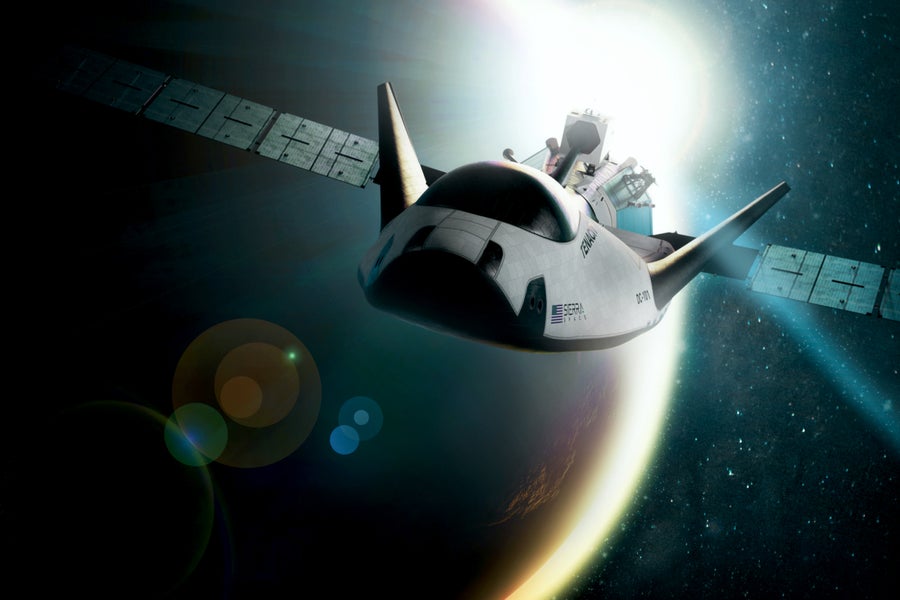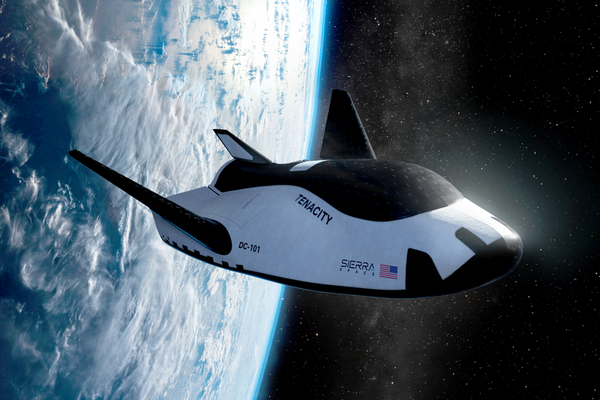With its perpetually upturned pectoral fins, and blunt nose, the Dream Chaser looks more like a killer whale than a spacecraft. But unlike an orca, the Dream Chaser will soon be going to orbit: it’s set to take food and supplies to the International Space Station (ISS) later this year when it travels to space for the first time.
The Dream Chaser’s trip to space will make it the latest commercial vehicle to visit the ISS as part of NASA’s “commercial resupply services” program. But leaders at Sierra Space, the company that built this finned craft, have visions that go beyond such deliveries: they hope that someday Dream Chaser will carry people to space and that it can act as a kind of ready-made space program for countries that don’t want to or don’t have the resources to reinvent these particular wheels. Beyond that, Sierra Space officials think Dream Chaser could deliver supplies or people to various places on Earth for the Department of Defense by going from point to point around the world at a faster clip than a typical plane.
But before any of that happens, Dream Chaser must make its maiden voyage, set for sometime later this year.
On supporting science journalism
If you're enjoying this article, consider supporting our award-winning journalism by subscribing. By purchasing a subscription you are helping to ensure the future of impactful stories about the discoveries and ideas shaping our world today.
NASA’s Space Shuttle was the original grocery deliverer and taxi service for the space station. As the shuttle retired in 2011, “we had to go start taking a look at a couple of avenues to support the space station,” says Phil Dempsey, ISS Transportation Integration Office manager. NASA turned to private corporations.
If companies could build space deliverers, NASA could simply buy their services instead of having to build and maintain its own vehicles. NASA’s first phase of contracts went to SpaceX and Orbital ATK (now Northrop Grumman). In the second phase, Sierra Space became the third company to win a contract. Sometime this year the Dream Chaser will be loaded onto a United Launch Alliance Vulcan Centaur rocket at Cape Canaveral, Fla., whose runway it will land on upon return.
Northrop’s cargo craft is called Cygnus, and it looks like a tin can that grew aerodynamically ineffective wings. It goes up but does not come down, “destructively reentering” the atmosphere—to use NASA’s violent euphemism for the craft burning up as it flies through the air—which lets it dispose of the station’s trash after it leaves. SpaceX’s solution is the Dragon capsule, which bears more resemblance to the classic Apollo spacecraft of old—with a modern, minimalist twist—and does return safely to Earth in a splashdown, after which it is ready to be reused. The journeys of these two craft weren’t always smooth sailing. “Both of the initial providers had early launch failures,” Dempsey says. Perhaps Dream Chaser will become a dream “catcher,” with fewer difficulties.

Sierra Space
Dream Chaser is a “lifting-body” spacecraft: it launches on a rocket but can land like an airplane on a runway, with its wide belly providing the lift that wings would on a conventional aircraft. It was initially intended for human occupants; the group had applied to take astronauts up to the ISS but didn’t win the contract. So when Sierra saw the option to send cargo, it decided to shoot for that star instead.
The company began modifying its people-pleasing design by taking out things that only humans need—such as windows and an abort system. It added the ability to carry up to 12,000 pounds of cargo total, with the addition of an attached capsule, and dispose of stuff on the way back down to Earth. Because Dream Chaser would ride to space in the five-meter fairing, or nose cone, of a rocket, the company redesigned the wings to fold up and be deployed in preparation for landing only once out of that claustrophobic space.
Dream Chaser is, in other words, a little less straightforward than Cygnus and Dragon. And because it lands on a runway, it can bring research home and hand off to scientists quickly—just half an hour after touchdown. During that touchdown, it will experience just 1.5 g’s of acceleration, providing a softer landing than a typical splashdown.
Dream Chaser can also dump its cargo capsule to burn up in the atmosphere on the way back down, letting it and whatever’s inside crisp into nothingness. “It gives a mix of the capabilities that the other two providers have,” Dempsey says. That gives NASA the flexibility, he continues, to choose which cargo carrier is best suited to a particular mission. For instance, the agency might use Dragon for critical cargo that needs to come back to the planet, Cygnus to get a huge amount of cargo up and Dream Chaser for time-sensitive research.
Each Dream Chaser is designed to fly 15 times before needing to be retired, so between the model that’s complete—named Tenacity—and another on the production floor, 30 future missions are possible. The company is also committed to building a crewed version of the space plane and eventually taking astronauts up, says Angie Wise, Sierra Space’s chief safety officer and senior vice president of mission and quality assurance. That goal meshes with another wing of the company’s business, she adds, which is working with Blue Origin on a commercial space station called Orbital Reef. The reef dwellers will have to get there somehow.
Wise says Sierra Space is focused on making this first mission successful rather than getting overhyped about the future. But the company does have a loose plan with the United Nations, if funding is secured, to launch an uncrewed international mission. Although the details aren’t nailed down, the U.N.’s description says such a mission would carry “experiments, payloads, or satellites provided by institutions in the participating countries.” Sierra Space is also talking to other governments about potential “free-flyer missions,” where the plane would simply loiter in orbit. It could host microgravity experiments onboard or give small satellites a lift and then let them go.
Beyond those aims, though, Sierra Space is also looking to the Department of Defense, where it thinks Dream Chaser could be useful for things such as peering down at Earth or rush delivering supplies to troops in faraway parts of the planet. “We can land pretty much on any major commercial runway,” Wise says. That special kind of delivery involves what insiders call “point-to-point” rocket travel: shooting spacecraft from one spot on the globe to another via an arc that cuts suborbitally through space. Up there, the craft could go thousands of miles per hour, compared with an airplane’s hundreds, and then slice through the atmosphere above its intended destination.
There aren’t any operational contracts in this direction yet, but the defense sector is broadly interested in such capabilities, and Sierra Space has signed a research agreement with the U.S. Transportation Command to look into “timely global delivery of Department of Defense logistics and personnel,” according to a press release. The Air Force, in particular, has its eye on point-to-point delivery. In addition to Dream Chaser, SpaceX’s Starship and spacecraft from Blue Origin and Rocket Lab could be put to such uses.
The Defense Innovation Unit (DIU), whose goal is to better and more quickly bring commercial technology under the military umbrella, recently took proposals for a program it calls Novel Responsive Space Delivery. In this program, the unit is looking for “responsive and precise point-to-point delivery of cargo to, from, and through space,” DIU said in its solicitation. That means DIU wants the service to go from Earth to orbit, from space to a specific spot on Earth and within space between satellites. In the future, the winners of such a contract might take upgrade or repair parts to an ailing satellite or even rescue people in space, should the need arise.
But DIU is also looking to a future time when the DOD might store supplies in space, as the U.S. military has at caches across Earth’s surface for many years. Then it would be able to send them where they’re needed, as they’re needed, if the usual terrestrial supply lines were in jeopardy or a disaster called for rapid response. “There are certain commodities that we can preposition in orbit. Certain commodities kind of lend themselves to being okay sitting in a space vehicle for some duration,” says Austin Baker, deputy director for DIU’s space portfolio.
Whether Dream Chaser will ever perform tasks like that is currently up in the air as it gets ready for its first launch. Right now it’s busy going through the rocket ringer, being tested to see how it holds up to conditions of launch and space itself. Sierra Space is “just checking out everything works on the ground before we ever launch it,” Wise says—to give it the best chance of coming back to the ground safely.
